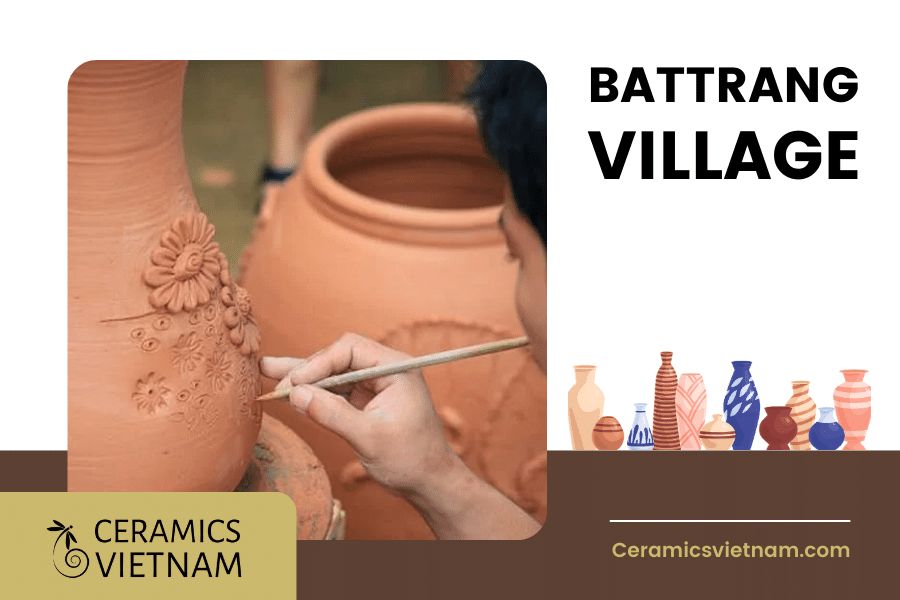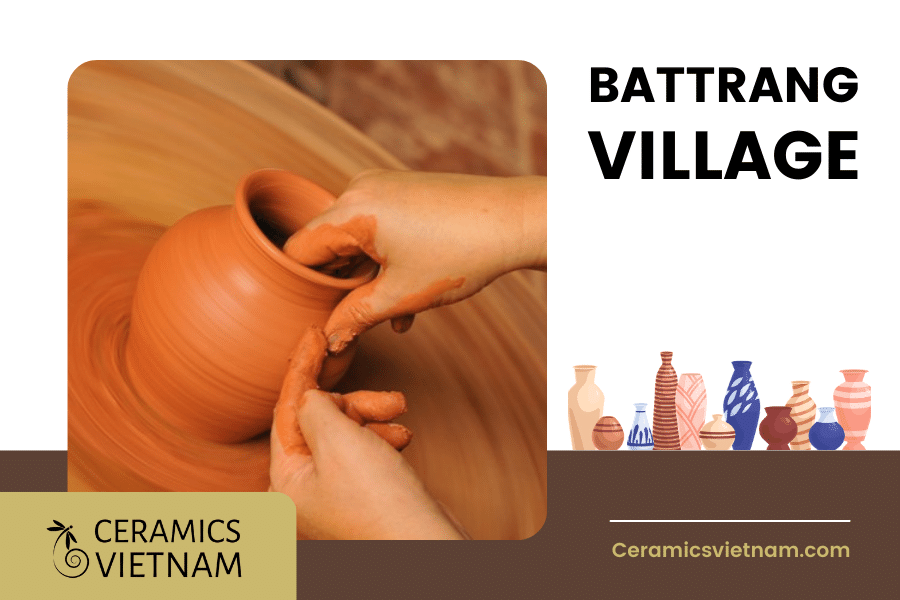Situated on the left bank of the Red River, approximately 13 kilometers southeast of the capital city, Bat Trang ceramics village in Gia Lam rural district of Hanoi has garnered renown as one of the country’s prominent tourist attractions, celebrated for its exquisite pottery and porcelain wares.
Bat Trang Ceramics Village: A Timeless Haven of Artistry and Beauty

Vietnamese ceramics Making ceramics in Bat Trang traditional craft village (1)
Nestled on the left bank of the majestic Red River, just 13 kilometers southeast of the capital city, lies Bat Trang ceramics village in the serene Gia Lam rural district of Hanoi. Over the years, this charming village has evolved into a celebrated and sought-after tourist destination, renowned for its exquisite pottery and porcelain creations.
The roots of Bat Trang‘s legacy can be traced back to the time of Thang Long, the capital city during the 11th to 14th centuries, known as Hanoi today. The establishment of Thang Long had a profound economic impact on various traditional craft villages, and Bat Trang was no exception.
According to local folklore, Bat Trang’s origins date back to the Ly dynasty. As King Ly Thai To relocated the capital city from Hoa Lu in Ninh Binh province to the bustling Thang Long in 1010, a group of enterprising traders and skilled craftsmen followed suit, choosing to settle in this new, promising hub. Among these pioneers were artisans from Bo Bat ceramics village in Yen Mo district of Ninh Binh province. They stumbled upon an abundance of white clay, the fundamental raw material for crafting ceramics, in the outskirts of the budding capital city, which would eventually become Bat Trang village. Recognizing the potential of this discovery, they decided to establish pottery kilns in the area.
With unparalleled craftsmanship and access to superior raw materials, Bat Trang gradually earned its reputation and emerged as a renowned center for ceramics in the country. The village flourished, and its pottery gained widespread admiration.
Bat Trang ceramics village now boasts a vast array of products, ranging from functional crockery and ornamental pieces to significant ceremonial objects. What sets Bat Trang pottery apart from other traditional ceramics villages are its distinctive embossed decorations and the striking ivory-white crackle glaze, both of which have become hallmarks of its masterful craftsmanship.
Visiting Bat Trang is not only a journey through time and history but also an opportunity to witness the continuation of an ancient art form that has stood the test of time. The village’s legacy lives on as it welcomes travelers from far and wide to experience the beauty and artistry of its world-renowned ceramics.
The process of making ceramics

Vietnamese ceramics Making ceramics in Bat Trang traditional craft village (1)
The making of ceramics in Bat Trang village involves a traditional four-step process, showcasing the skilled craftsmanship passed down through generations.
Preparing Raw Materials: The first step is to procure the essential raw materials for crafting ceramics – clay and glaze. In the past, Bat Trang artisans relied on locally available clay. However, as resources diminished over time, they had to seek alternatives from neighboring areas. They obtained clay from different locales, such as Phung Cong and Dan Nhiem villages in Van Giang district, Van Loc and Co Dien villages in Dong Anh district, and several others in Hung Yen, Hanoi, and Hai Duong provinces.
The clay undergoes a meticulous treatment process to eliminate impurities and achieve the desired consistency. Bat Trang craftsmen use four water tanks for this purpose. The raw clay is soaked in water for several months in the first tank, called the stirring ark. It is then transferred to the second tank, known as the sedimentation ark or filter ark, where impurities are separated, and the clay particles gradually settle. After that, the material is moved to the drying ark for further processing before being poured into the fermenting ark, where any remaining impurities are removed through fermentation. Additionally, kaolin or non-plastics may be added to prevent cracking during drying or firing.
The glaze-making process, on the other hand, remains a closely guarded secret handed down within families and the village. Glaze ingredients are carefully ground, screened, blended, and mixed with water to form a slurry. The slurry is poured into a glaze tank, allowing the colloids to suspend in the water while sediments settle at the bottom, resulting in clear glazes.
Bat Trang ceramics traditionally employ five types of glazes, with the ash glaze being the most popular, made from white clay, lime, and rice husk ash. Each artisan adds their unique touch to create distinct glaze variations despite using the same basic ingredients.
Shaping Clay: Bat Trang potters employ a technique called “throwing” to shape circular pieces like plates, cups, and bowls on foot-operated wheels. They start with a thoroughly wedged lump of clay, which is rolled into a coil and placed centrally on the wheel. As the wheel turns, the potter uses their hands to shape the clay piece, often employing pottery ribs and wires to achieve precision. Once the greenware, the freshly shaped pieces, are removed from the wheel, they are left to dry until they reach the leather-hard stage.
In the past, greenware used to dry on shelves in cool places, but nowadays, shaped clay pieces are gradually dried in kilns to control the evaporation process. Once the greenware reaches the leather-hard stage, craftsmen make final touches, such as trimming edges, carving decorative patterns, and adding handles or spouts for pots and vases.
Decorating and Glazing: Decorating pottery is an art in itself, and Bat Trang artisans use various techniques to embellish their creations. They employ colored glazes to create rings around the base and mouth-rim of products, use soil to create unique shapes, emboss patterns on the body of pottery items, and use brushes to draw decorative designs.
Glazing techniques vary, with some artisans choosing to fire their products first and then glaze them, while others prefer glazing directly on the shaped clay before firing. Glaze spraying is used for larger products. Before filling the kilns, any glazed defects on the products are meticulously removed.
Firing: The firing process is the crucial step that transforms clay into ceramics and raw works of art into finished masterpieces. Bat Trang potters previously used wood or coal-fueled kilns, each with its unique structure and firing techniques. For example, frog-shaped kilns, one of the oldest known kilns in the village, stack glazed items carefully from the center to the gate of the kiln to ensure consistent firing.
The firing process is not just a technical aspect but also carries cultural significance. Before lighting the fire, the oldest craftsman performs a ritual, walking around the kiln with incense sticks and a sacrificed dog or rooster, praying to the Jade Emperor and the fire god for a successful firing.
A wood kiln firing typically takes three days and three nights to complete. The temperature inside the kiln is gradually increased and then reduced slowly as the pottery reaches maturity. The finished ceramic products are left inside the kiln for three days before they are finally taken out, ready to be appreciated for their beauty and artistry.














Leave a reply